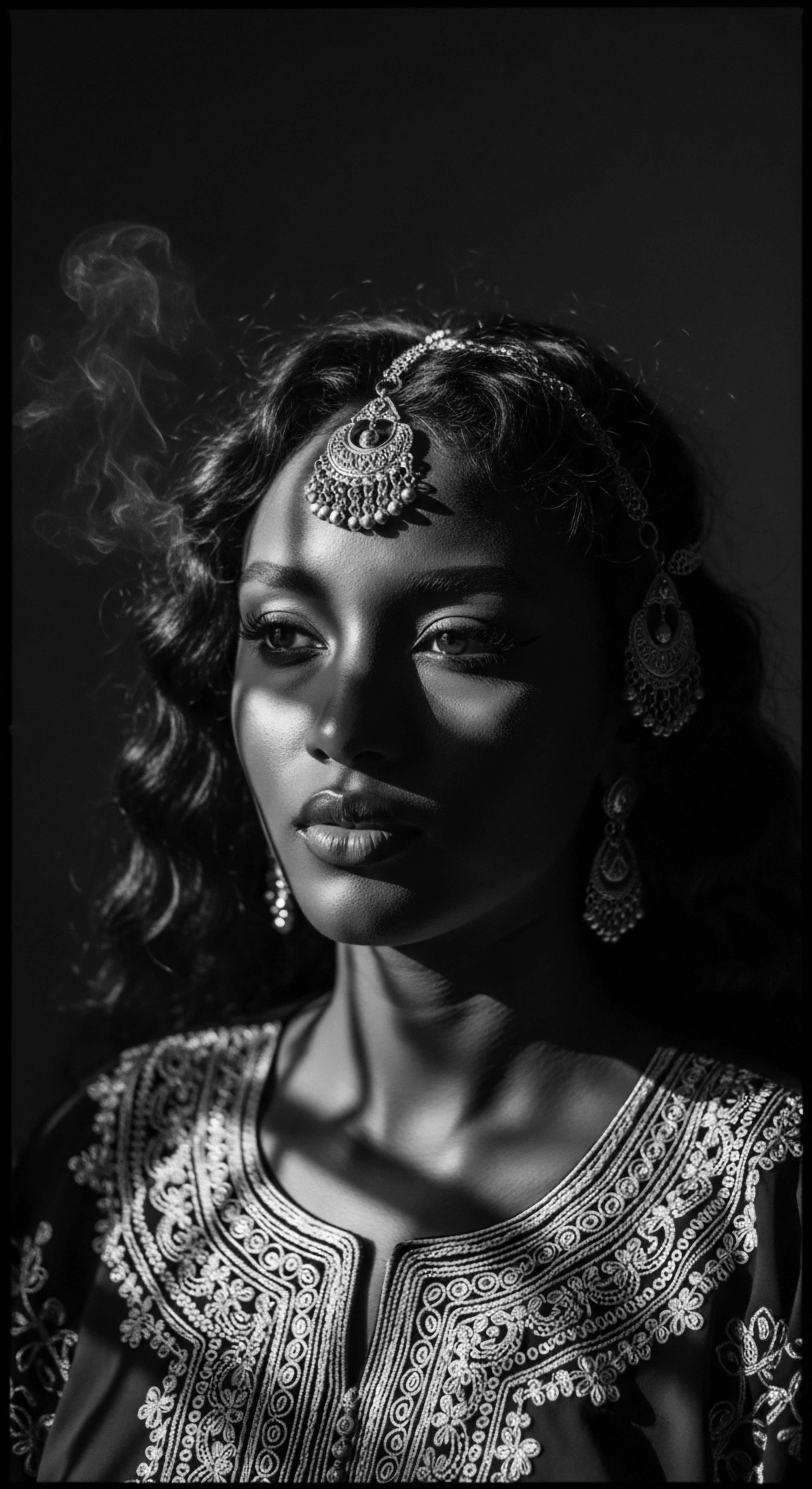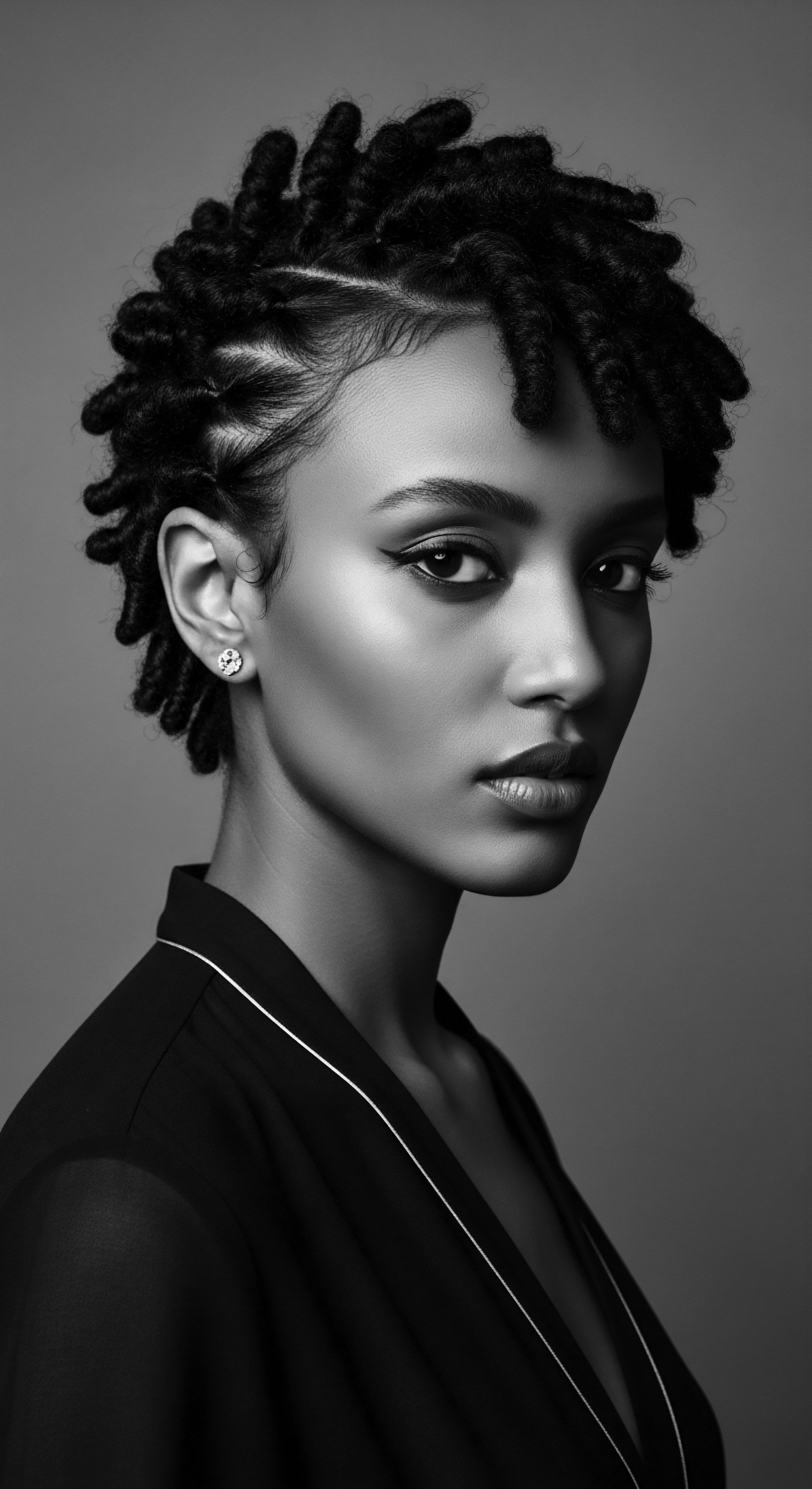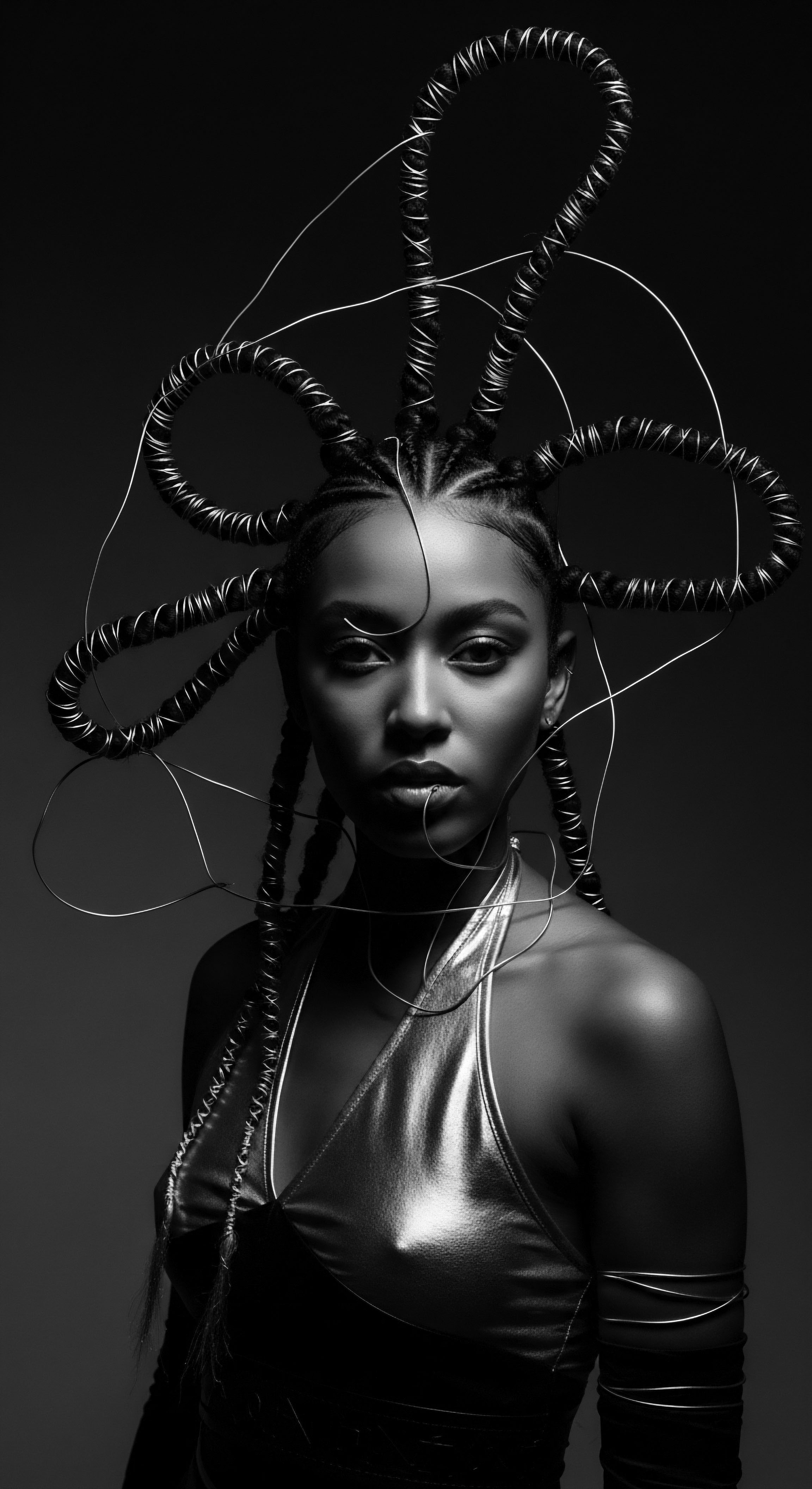
Roots
There exists within each curl, each coil, each vibrant wave, a whisper of time, a legacy etched not merely in genetic code but in the very soil from which our ancestors drew sustenance. It is a remembrance, a deep, persistent hum that speaks of sun-drenched fields and earth-bound wisdom, connecting our modern selves to generations long past. For those of us navigating the intricate terrain of textured hair, the journey of understanding often begins not with a product aisle or a trending technique, but with a quiet introspection into what truly nourishes us, from the inside out.
Can reclaiming ancestral foodways improve modern textured hair health and heritage? This inquiry asks us to consider a truth often overlooked in our fast-paced world ❉ that the vibrancy of our strands might well be intertwined with the dietary legacies of our forebears, a profound linkage between what we eat and who we are, a testament to enduring lines of life and care.

Echoes from the Source
The human relationship with sustenance stretches back to the earliest gatherings, shaping communities and influencing the very physicality of our bodies. For communities of African descent and those of mixed heritage, food was not simply fuel; it was a cornerstone of social structure, spiritual practice, and indeed, physical expression. Consider the millet and sorghum cultivated across ancient African civilizations, staples rich in essential minerals like iron and zinc, critical for healthy cell function and robust hair growth.
These grains, along with leafy greens and root vegetables, formed the basis of diets that supported not only strong bodies but, by extension, vibrant integumentary systems. The wisdom of these food systems, often practiced through sustainable agriculture and communal preparation, created a symbiotic relationship between humanity and the earth, where nourishment was understood holistically.
The journey of diasporic populations carried these foodways, sometimes adapted, sometimes preserved, across continents. The nutritional profiles of many traditional African, Caribbean, and Indigenous American diets were inherently conducive to wellness, offering a spectrum of vitamins, minerals, and fatty acids. These ancestral approaches to diet were built upon an understanding of what the local environment provided, a deep intimacy with the land that informed every meal. A diet rich in omega-3 fatty acids , often sourced from fish, nuts, and certain seeds, was not a supplement prescribed by a doctor but a natural part of living within a balanced ecosystem, influencing everything from cellular repair to the suppleness of the scalp.
Ancestral dietary patterns offer a forgotten blueprint for holistic health, including the vibrancy of textured hair.

The Textured Hair’s Molecular Narrative
The very architecture of textured hair, from its elliptical shaft to its unique distribution of disulfide bonds, renders it distinct, often requiring different levels of hydration and structural support. Collagen, a primary protein in hair structure, relies on adequate vitamin C intake, a nutrient abundant in many traditional fruit and vegetable preparations, such as those found in the Caribbean’s generous array of citrus and tropical fruits. The ancestral table, therefore, provided the molecular components necessary for the creation and maintenance of resilient strands.
Looking closer, the scalp itself, the very soil from which our strands arise, benefits from specific nutrients. Adequate B vitamins, especially biotin (found in eggs, nuts, and certain vegetables prevalent in historical diets), were fundamental for keratin synthesis. Iron deficiency, a common contemporary concern, can lead to hair shedding; historically, diets rich in heme iron from animal sources or non-heme iron paired with vitamin C for absorption from plant-based meals would have mitigated this challenge. The daily rhythm of these meals, passed down through generations, created a consistent supply chain of these vital building blocks.
- Grains ❉ Millet, sorghum, and fonio provided complex carbohydrates and essential minerals, supporting general metabolic health and keratin synthesis.
- Leafy Greens ❉ Callaloo, collards, and moringa delivered significant doses of iron, calcium, and vitamins A and C, essential for scalp circulation and collagen creation.
- Legumes and Seeds ❉ Black-eyed peas, lentils, and flax seeds supplied plant-based protein, biotin, and omega fatty acids, contributing to hair strength and sheen.
| Ancestral Food Category Root Vegetables (Yams, Cassava) |
| Key Nutrients Complex carbohydrates, Vitamin C, Potassium |
| Hair Health Benefit Energy for cell growth, antioxidant support, hydration |
| Ancestral Food Category Fermented Foods (Ogi, Injera) |
| Key Nutrients Probiotics, B vitamins |
| Hair Health Benefit Gut health (linked to nutrient absorption), keratin production |
| Ancestral Food Category Lean Proteins (Fish, Fowl) |
| Key Nutrients Amino acids, Iron, Zinc |
| Hair Health Benefit Hair protein building blocks, follicle strength, growth cycles |
| Ancestral Food Category Understanding these historical dietary patterns can inform contemporary choices for scalp and strand wellness. |

Ritual
The tender thread of care, from the earliest human settlements to our present days, has always been an intrinsic part of how we relate to ourselves and our communities. For textured hair, this care often moved beyond mere hygiene; it became a ritual, a profound connection to lineage, identity, and the very essence of well-being. Can reclaiming ancestral foodways improve modern textured hair health and heritage, especially when considering the hands-on acts of care passed down through time? The answer lies not just in ingestion, but in topical application, in the concoction of remedies drawn from the same earth that offered sustenance, a direct physical engagement with the legacy of our ancestors.

The Topical Legacy of Nourishment
Long before commercial conditioners and synthetic serums, our ancestors utilized what was readily available, transforming edible resources into powerful topical treatments. Oils rendered from coconuts , shea nuts, or palm kernels were not only dietary staples but served as deep conditioning agents, emollients, and protective barriers against the elements. These substances, rich in lauric acid, oleic acid, and various fatty acids, possessed properties that modern science now validates ❉ they seal moisture, reduce protein loss, and contribute to the hair’s overall pliability. The practice of oiling the hair and scalp was not an occasional indulgence but a regular act of care, often performed communally, solidifying bonds and transmitting knowledge.
Herbal rinses, infusions made from leaves and barks, also played a significant role. Plants like hibiscus , often brewed into teas for consumption, found a dual purpose as hair rinses, believed to stimulate circulation to the scalp and impart shine. The mucilage from okra pods, another culinary staple, was traditionally used as a natural detangler, its slippery consistency assisting in managing tightly coiled textures without harsh chemicals. These acts of preparation and application were rituals in their purest form, embodying patience, connection, and a deep, intuitive understanding of nature’s bounty.

Styling as a Story of Sustenance
The art of textured hair styling is a living archive, each braid, twist, or cornrow carrying stories of resilience, status, and community. Many traditional styles, often intricate and long-lasting, required hair that was not only clean but deeply nourished and pliable. Ancestral foodways contributed to this pliability. Consider the long-held practice of braiding or coiling hair after application of natural oils and butters derived from food sources.
This process, repeated over generations, helped to train the hair, reducing breakage and promoting length retention. The resilience of the hair itself was a testament to the comprehensive care, both internal and external, it received.
The use of specific tools also reflects this deep connection. Wooden combs, often carved from local trees, were gentle on the hair, distributing natural oils from scalp to tip. The hands themselves, imbued with the wisdom of generations, were the primary instruments, carefully sectioning, twisting, and shaping the hair. These techniques, often passed from elder to youth, were not merely about aesthetics; they were about preserving the health of the strands, protecting them from environmental damage, and maintaining their structural integrity, all rooted in practices that often began with the cultivation and preparation of food-derived remedies.
The historical application of edible oils and botanical infusions reflects a profound ancestral insight into hair’s intrinsic needs.

Relay
The passing of knowledge from one generation to the next, the relay of wisdom through time, forms the very backbone of heritage. This continuous transfer, often subtle and embedded in daily practice, carries profound implications for our understanding of wellness, particularly when considering the intimate relationship between ancestral foodways and the vibrancy of textured hair. Can reclaiming ancestral foodways improve modern textured hair health and heritage, not just as a historical curiosity, but as a dynamic pathway for contemporary well-being? This question invites us to consider how ancient practices, often sustained by the very foods that nourished communities, offer concrete, scientifically resonant benefits in the modern context, bypassing surface observations to deliver a deep grasp of interconnectedness.

Bridging Ancient Wisdom with Modern Science
The scientific understanding of cellular nutrition and dermatology now provides empirical validation for many ancestral food practices concerning hair health. For instance, the traditional diet of many West African communities, before the advent of widespread processed foods, was notably rich in plant-based proteins, complex carbohydrates, and micronutrients. Research has shown that these diets, abundant in diverse fruits, vegetables, and whole grains, contribute to a robust microbiome, which in turn influences systemic inflammation and nutrient absorption – both critical for healthy hair follicles.
A study by Agbai and McMichael (2018) highlighted the prevalence of nutritional deficiencies , particularly iron, zinc, and vitamin D, in individuals experiencing hair loss, noting that diets emphasizing whole, unprocessed foods, akin to ancestral patterns, are often associated with better outcomes. This suggests a direct correlation between the holistic nutritional profile of historical diets and the enduring health of textured strands.
Consider the role of collagen synthesis . Ancestral diets often included bone broths and organ meats, which provide rich sources of amino acids necessary for collagen production. Collagen, a fibrous protein, forms the structural scaffold for hair strands. While modern diets might lean on synthetic supplements, our ancestors acquired these vital components through a balanced, varied intake of culturally specific foods.
Furthermore, the anti-inflammatory properties of certain plant-based foods, such as those rich in polyphenols (found in berries, green leafy vegetables, and specific herbs traditionally consumed), directly combat scalp inflammation, a common precursor to various hair concerns. These ancient dietary habits, therefore, were not merely coincidental but deeply preventative, laying a foundation for resilient hair from within.
| Ancestral Foodway Principle Nutrient-Dense Whole Foods |
| Modern Hair Health Challenge Addressed Vitamin/Mineral Deficiencies leading to brittleness or shedding |
| Ancestral Foodway Principle Anti-Inflammatory Botanicals |
| Modern Hair Health Challenge Addressed Scalp irritation, dryness, or conditions like folliculitis |
| Ancestral Foodway Principle Balanced Macronutrient Intake |
| Modern Hair Health Challenge Addressed Lackluster strands, slow growth, or general weakness |
| Ancestral Foodway Principle Reconnecting with these ancient dietary patterns offers a potent strategy for addressing contemporary textured hair concerns. |

Unpacking the Heritage of Hair Regimens
The journey of reclaiming ancestral foodways for hair health is not simply about consuming specific foods; it is about adopting a philosophy of holistic well-being that views the body, mind, and spirit as interconnected, a worldview deeply woven into the heritage of many Black and mixed-race communities. This philosophy extends to hair care regimens. The careful selection of ingredients, the deliberate, patient application of oils and butters, and the communal aspect of hair styling all echo a deeper reverence for the body as a temple, for hair as a crown. A modern regimen inspired by ancestral wisdom might prioritize:
- Internal Nourishment ❉ Emphasizing a diet rich in fruits, vegetables, whole grains, and lean proteins, consciously choosing foods known to support hair health, such as those that provide adequate iron (e.g. lentils, dark leafy greens) and zinc (e.g. pumpkin seeds, nuts).
- Topical Application of Food-Derived Botanicals ❉ Utilizing oils like shea butter , coconut oil , or jojoba oil for sealing moisture and enhancing pliability, much as they were used in historical contexts. Herbal rinses from rosemary or neem leaves can also be incorporated to support scalp circulation and address specific concerns.
- Mindful Rituals ❉ Approaching hair care as a deliberate, nourishing act, not a chore. This might involve setting aside dedicated time for deep conditioning, engaging in scalp massages to stimulate blood flow, and protecting strands at night with silk or satin bonnets, a practice with a long and dignified heritage across the diaspora.
Reclaiming ancestral foodways is a profound act of self-care and cultural affirmation for textured hair.

Can Dietary Shifts Influence Hair Texture and Growth?
The direct influence of diet on hair texture, particularly its curl pattern, is complex and primarily determined by genetics. However, dietary shifts can profoundly influence the health and growth of existing textured hair. For instance, deficiencies in specific nutrients like protein, biotin, or essential fatty acids can lead to thinner, weaker strands, increased breakage, or slowed growth, irrespective of the intrinsic curl pattern (Rushton, 1993). By consciously re-engaging with foodways that historically provided these vital nutrients in abundance, individuals can observe improvements in hair elasticity, strength, and overall vitality.
The hair might feel softer, appear shinier, and experience reduced shedding. This is not about altering one’s inherent hair structure, but about optimizing its potential for vibrant growth and resilience, drawing from the deep well of inherited knowledge that informed ancestral well-being.

Reflection
As the light of modern understanding meets the long shadows of our past, a profound truth emerges ❉ the very heart of textured hair health, its unique vitality and resilience, is intimately intertwined with the echoes of ancestral foodways. This exploration has been a journey through the fundamental biology of a strand, tracing its lineage back to the soil that nourished generations, through the deliberate hands that performed rituals of care, and into the contemporary understanding of what truly sustains us. The ‘Soul of a Strand’ whispers of a deep, unbroken connection—a testament to the enduring wisdom of those who came before. It suggests that in the simplicity of a forgotten grain, the richness of a traditionally rendered oil, or the purposeful act of preparing a meal, lies a powerful wellspring for our present and future well-being.
Reclaiming these foodways is not merely a dietary adjustment; it is an act of profound remembrance, a re-engagement with a heritage that speaks of strength, adaptation, and an unwavering commitment to flourishing. It is a quiet revolution, transforming our approach to textured hair care from a fragmented pursuit of temporary fixes to a holistic, deeply rooted practice. In choosing to honor the wisdom of our ancestors, through the foods we eat and the care we bestow upon our hair, we contribute to a living archive, adding our own chapters to the timeless narrative of textured hair heritage. This journey, personal and communal, allows us to nurture not just our strands, but the very essence of our lineage, ensuring that the legacy of vibrance continues its relay for generations yet to come.

References
- Agbai, E. & McMichael, A. (2018). Nutritional considerations in hair loss. In J. D. L. Shavell (Ed.), Hair Disorders ❉ A Comprehensive Guide (pp. 129-140). Springer.
- Rushton, D. H. (1993). Nutritional factors and hair loss. Clinical and Experimental Dermatology, 18(2), 109-115.
- Walker, A. (2001). The Temple of My Familiar. Harvest Books.
- hooks, b. (1990). Yearning ❉ Race, Gender, and Cultural Politics. South End Press.
- Joyner, M. (1987). The Legacy of Madame C.J. Walker ❉ African American Hair Care Entrepreneurship. Black Classic Press.
- Davidson, B. (1966). A History of West Africa ❉ 1000-1800. Longman.
- Mintz, S. W. (1985). Sweetness and Power ❉ The Place of Sugar in Modern History. Penguin Books.
- Pollan, M. (2006). The Omnivore’s Dilemma ❉ A Natural History of Four Meals. Penguin Press.
